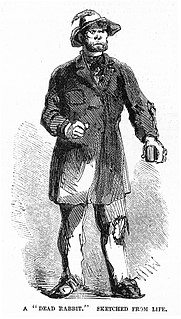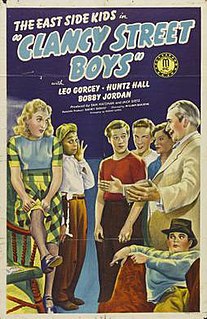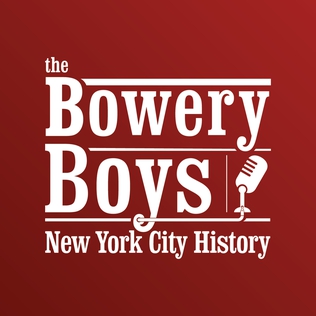
Five Points was a 19th-century neighborhood in Lower Manhattan, New York City. The neighborhood, partly built on land that had filled in the freshwater lake known as the Collect Pond, was generally defined as being bound by Centre Street to the west, the Bowery to the east, Canal Street to the north, and Park Row to the south. The Five Points gained international notoriety as a densely populated, disease-ridden, crime-infested slum that existed for over 70 years.

Gangs of New York is a 2002 American historical drama film directed by Martin Scorsese and written by Jay Cocks, Steven Zaillian and Kenneth Lonergan, based on Herbert Asbury's 1927 book The Gangs of New York. The film stars Leonardo DiCaprio, Daniel Day-Lewis and Cameron Diaz, with Jim Broadbent, John C. Reilly, Henry Thomas, Stephen Graham, Eddie Marsan and Brendan Gleeson in supporting roles.

The Dead Rabbits was the name of an Irish American criminal street gang active in Lower Manhattan in the 1830s to 1850s. The Dead Rabbits were so named after a dead rabbit was thrown into the center of the room during a gang meeting, prompting some members to treat this as an omen, withdraw, and form an independent gang. Their battle symbol was a dead rabbit on a pike. They often clashed with Nativist political groups who viewed Irish Catholics as a threatening and criminal subculture. The Dead Rabbits were given the nicknames the "Mulberry Boys" and the "Mulberry Street Boys" by the New York City Police Department because they were known to have operated along Mulberry Street in the Five Points.

The Bowery is a street and neighborhood in Lower Manhattan, New York City. The street runs from Chatham Square at Park Row, Worth Street, and Mott Street in the south to Cooper Square at 4th Street in the north. The eponymous neighborhood runs roughly from the Bowery east to Allen Street and First Avenue, and from Canal Street north to Cooper Square/East Fourth Street. The neighborhood roughly overlaps with Little Australia. To the south is Chinatown, to the east are the Lower East Side and the East Village, and to the west are Little Italy and NoHo. It has historically been considered a part of the Lower East Side of Manhattan.
Bowery is an anglicization of Bouwerie, the archaic form of the Dutch for "farm", that was used in numerous New Netherland placenames. It most prominently refers to a street in Lower Manhattan, New York City.

William Poole, also known as Bill the Butcher, was the leader of the Washington Street Gang, which later became known as the Bowery Boys gang. He was a local leader of the Know Nothing political movement in mid-19th-century New York City.

The Roach Guards were an Irish criminal gang in Five Points neighborhood of New York City the early 19th century. The gang was originally formed to protect New York liquor merchants in Five Points and soon began committing robbery and murder. The Roach Guards took their name from their founder and leader Ted Roach.

The Shirt Tails were a mid-19th-century street gang based in the Five Points slum in Manhattan, New York, United States, who wore their shirts on the outside of their pants as 19th-century Chinese laborers would dress as a form of insignia and as a sign of gang group affiliation. Members kept their weapons—as many as three or four at a time—concealed beneath their shirts; this discreet measure stands in contrast to competing gangs who flaunted their weapons in order to intimidate.

The Chichesters also known as the Chichester Gang, along with the Forty Thieves, Shirt Tails, and Kerryonians, were one of the oldest early 19th century Irish Five Points street gangs during the mid 19th century in New York City. The Chichester Gang was organized by its founder John Chichester. The gang got their start by stealing from stores and warehouses and selling the stolen goods to local fences in the 1820s and later became involved in illegal gambling and robbery. An ally of the Dead Rabbits against the Bowery Boys, the Chichesters maintained between 50-100 members lasting for more than 50 years before being absorbed by the Whyos, much like many of the early gangs, following the American Civil War in 1865.
The Daybreak Boys was a New York City street gang during the mid nineteenth century.

The New Yorker vernacular pronunciation of Bowery Boys was Bowery B’hoys referring to working-class single men living mostly along the Bowery in New York City in the early 19th century. Notorious for their rowdy behavior and bright clothes, these men participated actively in theatre audiences during their time away from work and their living wards.

Clancy Street Boys is a 1943 comedy film directed by William Beaudine and starring the East Side Kids. It is Beaudine's first film with the team; he would direct several more in the series and many in the Bowery Boys canon. Leo Gorcey married the female lead Amelita Ward. There is no mention of "Clancy Street" in the film, but a rival gang at Cherry Street appears at the beginning and climax of the film.
The Bowery Boys are fictional New York City characters, portrayed by a company of New York actors, who were the subject of 48 feature films released by Monogram Pictures and its successor Allied Artists Pictures Corporation from 1946 through 1958.

The Bowery Boys were a nativist, anti-Catholic, and anti-Irish criminal gang based in the Bowery neighborhood of Manhattan, New York City in the early-mid-19th century. In contrast with the Irish immigrant tenement of the Five Points, one of the worst city slums in the United States, the Bowery was a more prosperous working-class community. Despite its reputation as one of the most notorious street gangs of New York City at the time, the majority of the Bowery Boys led law-abiding lives for the most part. The gang was made up exclusively of volunteer firemen—though some also worked as tradesmen, mechanics, and butchers —and would fight rival fire companies over who would extinguish a fire. The Bowery Boys often battled multiple outfits of the infamous Five Points, most notably the Dead Rabbits, with whom they feuded for decades. The uniform of a Bowery Boy generally consisted of a stovepipe hat in variable condition, a red shirt, and dark trousers tucked into boots—this style paying homage to their firemen roots.

The Gangs of New York: An Informal History of the Underworld is an American non-fiction book by Herbert Asbury, first published in 1927 by Garden City Publishing Company.

The Dead Rabbits riot was a two-day civil disturbance in New York City evolving from what was originally a small-scale street fight between members of the Dead Rabbits and the Bowery Boys into a citywide gang war, which occurred July 4–5, 1857. Taking advantage of the disorganized state of the city's police force—brought about by the conflict between the Municipal and Metropolitan police—the fighting spiraled into widespread looting and damage of property by gangsters and other criminals from all parts of the city. It is estimated that between 800 and 1,000 gang members took part in the riots, along with several hundred others who used the disturbance to loot the Bowery area. It was the largest disturbance since the Astor Place Riot in 1849 and the biggest scene of gang violence until the New York Draft Riots of 1863. Order was restored by the New York State Militia, supported by detachments of city police, under Major-General Charles W. Sandford.

Gang colors include clothing, accessories, or tattoos of a specific color or colors that represent an affiliation to a specific gang or gang branch.

The Bowery Boys: New York City History is a travel and history podcast that was launched in June 2007 by Thomas Meyers and Gregory Young. Podcast episodes focus on the history of one person, place, or event in New York City history. As of December 2020, the Bowery Boys have produced 348 episodes.
The Atlantic Guards were a 19th-century American street gang active in New York City from the 1840s to the 1860s. It was one of the original, and among the most important gangs of the early days of the Bowery, along with the Bowery Boys, American Guards, O'Connell Guards, and the True Blue Americans.

The Short Tails also known as the Short Tail Gang for their distinctive short tailed jacket coats were an 1880s-1890s Irish gang located in the Corlear's Hook section of the Lower East Side on Rivington street in the vicinity of Mangin and Goerck streets of Manhattan, in New York City. The Eastman Gang were also headquartered around Corlear's Hook and may have had its beginnings as a break away gang of the Short Tail Gang. The Short Tails along with rival gangs the Daybreak Boys, Patsy Conroy Gang, Swamp Angels, and Hook Gang worked the New York City waterfront plundering ships of their cargo on the East River. The Short Tail Gang was photographed in 1887, under a pier by noted photographer Jacob Riis, being one of the few 19th century New York gangs to allow its members to be photographed. In fear of being identified and arrested by the law, usually individual police mug shots were the only criminal pictures known to exist.











